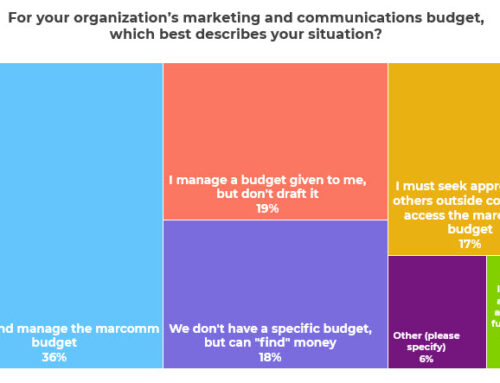
Every nonprofit communications director I know has way too much work to do. It’s the nature of comms work (so many ideas, so many channels, etc.) and the nature of nonprofit work, where we often think we have to do everything for everyone right away.
But we can’t do it all at once. We have to make decisions and prioritize based on the capacity we have available. That capacity includes how much time you as a communications pro have in a day or week or month.
So what do you work on and what do you set aside for another day (or maybe never)? What should come first? What gets your best thinking and energy?
One approach to prioritizing is to think about how important communications and marketing are to the success of the organization’s larger, mission-oriented goal.
For example, if you run a social service program that has a 10-12 month waitlist, you probably don’t need to do a lot of marketing to encourage people to use the service. They are already finding out some other way and you don’t have the capacity to serve more people. Continuing to market it when you can’t really deliver could actually hurt your organization.
But what if you are running a brand-new training program for a group of people that you don’t normally engage with very often? In that case, you need a comms strategy that not only introduces your organization to those people and starts to build trust with them, but that also encourages them to attend your training program. Without that marketing plan, the training program is likely to fail.
I found the following approach in a white paper from Forum One called Do Your Communications Efforts Measure Up? It says that Pew Charitable Trusts’ evaluation team uses these criteria to assess program impact:
Decisive: The weight of evidence suggests the outcome would not have been achieved without the program’s efforts.
Important: Multiple actors contributed to the outcome and we played a substantive role.
Inconsequential: The program played little or no part in the outcome, implying that the outcome would have occurred without its involvement.
So translate this to your comms and marketing work: Where is your comms work decisive in meeting mission goals?
Where is it important?
And how about places where comms is inconsequential (be honest!)? What would go on and be just fine without communications support?
I like Likert scales, so you could also use one those to expand on this. For example, you can take your mission goals or projects you are being asked to support with communications and marketing work and assign a score:
- 0 = Comms is Not Important At All to Success
- 1 = Comms is of Little Importance to Success
- 2 = Comms is of Average Importance to Success
- 3 = Comms is Very Important to Success
- 4 = Comms is Absolutely Essential to Success
Now of course, for this to work, you have to define what success looks like! That’s often a new and challenging conversation with your leadership and program staff, but it’s one that absolutely has to happen. Then you can decide just how important communications assistance is to achieving that success or if other factors will be more important.
If the work will go on well without you, it probably shouldn’t be a priority for your comms staff. Focus your time where comms is very important or absolutely essential to success.





